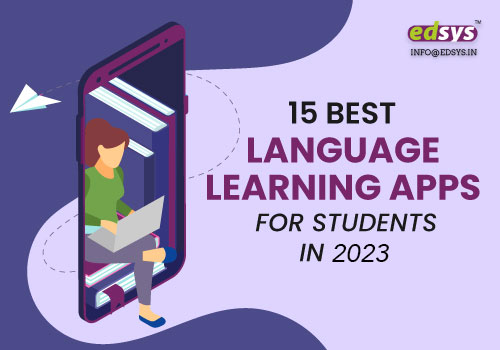Learning a new language has a lot to do with the development of your brain, as your brain will have to cope up with the new complexities and sentence structures of a new language too. This is where the language learning apps can help you.
Studies claim that, it takes about 48 days for a person to learn and speak a language fluently. But due to technological advancements, we have dozens of language learning apps to enhance our language skills.
Get FREE Spanish Learning Apps (Check it Now)
Here are 15 best rated language learning apps to ease your learning process
1. Mem Rise

- Ratings: 4.6
- Installs: 10,000,000+
- Size: 8.1 MB
-
Last Updated: 2 April, 2020
Memrise is one of the best language learning apps with hundreds of video clips of native local speakers and effective language games to enhance your language learning skills.
Features:
- Learn with Locals
- Improve pronunciation
- Learn anywhere
- Practice through games
2. Duolingo
- Ratings: 4.7
- Installs: 100,000,000+
- Size: Varies with device
-
Last Updated: 31 March, 2020
Duolingo is a language application designed to teach aspirants of any age, without any efforts. This app is a perfect solution to conquer a new language.
Features:
- Fun and interactive app with images and voice recordings
- Learn more in less time
- Less adds
- Easy to navigate
3. Busuu

- Ratings: 4.4
- Installs: 100,000,000+
- Size: 17 MB
-
Last Updated: 1 April, 2020
Busu is a language app which is focused more towards serious learners. It helps to learn a dozen different languages with ease.
Features:
- Practise speaking with native speakers
- Learn hundreds of new words
- Understand grammar
- Receive official certification with McGraw Hill language certificates
4. Innovative 101

- Ratings: 4.6
- Installs: 1,000,000+
- Size: 14 MB
-
Last Updated: 5 December 2019
Innovative 101 is a language learning app which focuses more on communication. It has study tools for a better understanding of language.
Features:
- Free audio and video lessons
- More focused on communication
- Powerful study tools to learn faster
Get FREE Spanish Learning Apps (Check it Now)
5. Drops Language

- Ratings: 4.6
- Installs: 1,000,000+
- Size: 28 MB
-
Last Updated: March 30, 2020
Drops language is a phone app that covers almost 33 languages with daily games and other such interesting activities.
Features:
- 100% visual
- Hundreds of mock-tests
- 5 minute practice sessions
- Focuses on vocabulary
6. Babbel

- Ratings: 4.6
- Installs: 10,000,000+
- Size: 28 MB
-
Last Updated: April 3, 2020
This language learning app enables the learner to build a better language with better learning experience. It helps a learner to learn a new language with confidence.
Features:
- Interactive lessons
- Improves pronunciation
- Teaches to listen, read, write and speak
- More than 6000 language classes
7. Learn Match

- Ratings: 4.7
- Installs: 1,000,000+
- Size: Varies with Device
-
Last Updated: Jan 29, 2020
Learn Match is a personalized learning app with many courses, dictionaries, translations etc. This app provides a language learner what he needs under a single umbrella.
Features
- Full of activities
- Personalized courses
- Activities
- Vocabulary sessions
8. Travel Phrasebook

- Ratings: 4.6
- Installs: 1,000,000+
- Size: 49 MB
-
Last Updated: Feb 14, 2020
Travel Phrase book is a learning app customized mainly for travellers. Thus it has many useful foreign words and phrases. Using this app, one can learn a language without a facilitator.
Features:
- No internet connection required
- Customizable font size
- Many useful foreign phrases and words available
- Has voice recording and playback options
- Instant search by keywords option available
Get FREE Spanish Learning Apps (Check it Now)
9. Flashcards maker

- Ratings: 4.8
- Installs: 100,000+
- Size: 17 MB
-
Last Updated: Feb 22, 2020
This is an application which makes the makes the learning process of a new language aspirant easier, which its multiple features and unique features.
Features:
- Ad free app
- Dictionary mode available
- Listen to previously learned words or phrases
- Auto player mode
- Supports 118 languages
“Edsys For Education” Presenting Teacher App – A Complete Class Schedule and Attendance Management App
10. Poro

- Ratings: 4.8
- Installs: 100,000+
- Size: 93 MB
-
Last Updated: Feb 9, 2020
This is one of the easiest and effective self-learning apps, to learn various lessons like greeting, introduction, business conversation etc.
Features
- More than 750 lessons of common conversation
- Transcription available for videos and audios
- Playlist mode available
- Learn through news and stories
- Practice lessons via games
Download: Android
11. Enguru

- Ratings: 4.6
- Installs: 5,000,000+
- Size: 68 MB
-
Last Updated: April 3 2020
Enguru is an English learning revolutionary app which enables self-learning. It guarantees to teach the learn English confidently, quickly and fluently.
Features
- Completely free course
- Live English Classes
- Live IELTS English classes
- English video and news available
- Fun vocabulary games
- Ad free app
Download: Android
Also Read: 20 Best Attendance Apps For Teachers
12. English Vocabulary Daily

- Ratings: 4.6
- Installs: 1,000,000+
- Size: 6.5 MB
-
Last Updated: Nov 17, 2019
English vocabulary daily is a free offline vocabulary app to help the learners to learn the language in a simpler and easier way.
Features
- 7 level English vocabulary
- Many audio content available
- Reminds learned words and phrases
- Easy to store and manage favorite items
Download: Android
13. Speedy English Grammar

- Ratings: 4.7
- Installs: 10,000,000+
- Size: 27 MB
-
Last Updated: June 19, 2019
Speedy English Grammar is a grammar and vocabulary builder that contains over more than 2000 simple grammar and vocabulary lessons.
Features:
- Includes even elementary classes
- Grammar reference book available
- IELTS and TOEIC preparation classes available
- Filled with fun and interactive learning games
Download: Android
Get FREE Spanish Learning Apps (Check it Now)
14. ELSA Speak

- Ratings: 4.9
- Installs: 1,000,000+
- Size: 19 MB
-
Last Updated: April 1, 2020
ELSA Speak is an ultimate English speaking practice app for English learners. This is one of the learning apps with an award-winning speech recognition technology to figure out the pronunciation mistakes.
Features:
- Curriculum tailored to improve speaking level
- Classes on how to move your tongue and lips while speaking
- IELTS,TOEFL and TOEIC preparation classes available
15. All Languages Translator

- Ratings: 4.4
- Installs: 10,000,000+
- Size: 4.1 MB
-
Last Updated: Nov 14, 2019
This is one of the best translation apps with its free voice translation feature. It is also supported by speech translator app.
Features:
- Voice translation available
- Text to speech functionality
- Translate words and sentences
Download: Android
It is really important to check the relevancy along with the features of an app before starting to learn the language.
The above mentioned language learning apps will let you know more about the best rated language apps.
So go with the Best Ever Language Learning Apps. All the Best!!!!












